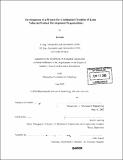Development of a process for continuous creation of lean value in product development organizations
Author(s)
Kato, Jin
DownloadFull printable version (20.75Mb)
Other Contributors
Massachusetts Institute of Technology. Dept. of Mechanical Engineering.
Advisor
Warren Seering.
Terms of use
Metadata
Show full item recordAbstract
Ideas and methodologies of lean product development were developed into tools and processes that help product development organizations improve their performances. The definition of waste in product development processes was re-examined and developed into a frugal set to cover all types of waste in product development processes through preliminary case studies. Value stream mapping (VSM) was optimized for measuring the waste indicators in product development processes. Typical causes for low product development project performances were organized into a root-cause analysis diagram. Three case studies in product development companies were performed. The tools were tested and improved through intensive interviews with both project managers and engineers. VSM was effective for identifying and measuring waste indicators. The root-cause analysis diagram was effective for quickly identifying root causes for low product development project performances. Synchronized uses of these tools made it possible to measure each root cause's impact on project performances. The result of measurements revealed both problems shared by all the projects and the ones specific to the projects, indicating that the tools and processes developed in this research can provide suggestions for continuous improvement of product development processes. Some waste indicators were more prevalent than the others, implying that the number of waste indicators to be considered can be reduced. Inventory of information was prevalent in all the projects, and the analyses of it implied that Today's product development processes are as premature as those of manufacturing several decades ago. (cont.) Wastefulness of information inventory was proved quantitatively. Time spent on one occurrence of rework was proved to take longer near the end of a project than at the beginning of it.
Description
Thesis (S.M.)--Massachusetts Institute of Technology, Dept. of Mechanical Engineering, 2005. Includes bibliographical references (p. 205-206).
Date issued
2005Department
Massachusetts Institute of Technology. Department of Mechanical EngineeringPublisher
Massachusetts Institute of Technology
Keywords
Mechanical Engineering.